On Monday, May 16th a new wave of mobilisations of Bolivian workers and peasants broke out, which is increasingly raising the question of power once again. The Bolivian masses are revealing an unprecedented level of revolutionary determination to see the struggle through to the end.
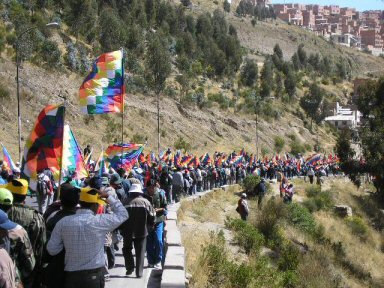 |
MAS peasants arrive in La Paz after 190km march Picture:Indymedia Bolivia |
On Monday, May 16th a new wave of mobilisations of Bolivian workers and peasants broke out, which is increasingly raising the question of power once again. The passing of the new Hydrocarbons Law sparked off this latest round of strikes, road blockades, marches and mass demonstrations.
This confirms that the revolutionary uprising which overthrew the government of Sanchez de Losada back in October 2003 was not decisively concluded in favour of the workers and peasants, and their main demands (the nationalisation of the gas and oil resources of the country, now in the hands of multinationals) were not met.
Since then, the new president Mesa has tried to manoeuvre between the powerful interests of the multinationals and the radicalised masses of workers and peasants. The problem is that the interests of both cannot be reconciled.
A month ago Mesa made a dramatic broadcast on national TV in which he revealed the real situation. “The multinationals are ruling the country” he explained, and therefore no hydrocarbons law can be passed that does not please them. He was basically saying: if you do not want me, I will resign and then you will have to deal with the national assembly which is even more reactionary than I am. It was a desperate bid to demobilise the workers and peasants and stay in power, a typical Bonapartist trick which seemed to be working, but which only held the situation for a few more weeks.
The hydrocarbons law proposed by Mesa, increases the taxes on multinational companies, leaving royalties at the same level, but falls short of the demand of what was agreed in a referendum one year ago: 50% royalties on gas and oil extraction. This was the proposal put forward by Mesa and supported by Evo Morales, the leader of the Movement Towards Socialism (MAS), which has its main base of support among the coca-growing peasants in the Chapare regions.
The proposal was in fact an attempt to defuse the demand for nationalisation raised by the Bolivian Workers’ Union (COB) and the workers’ organisations in El Alto, the working class city just outside La Paz which played a key role in the October 2003 uprising. The questions in the referendum were posed in such a way as to push people into voting for that option, and was therefore dubbed the “tramparendum” (trickerendum) by the workers’ organisations.
But even this compromise of imposing 50% royalties on the multinationals is too much for them and they have already made clear that they will not accept it. And as Mesa pointed out, it is they who rule the country! In fact throughout the process of discussion of the Law in the national assembly the multinationals (and the US embassy) made clear their position that any substantial modification of the extremely favourable contracts they got under the previous Losada government would be unacceptable to them. But those contracts were so outrageous (allowing the multinationals to get gas at below market prices and then sell it back to Bolivia at prices well above international market prices) that they were all declared void by the Constitutional Court, as they had not been ratified by parliament.
So, for a year and a half this pushing and shoving between the multinationals, the national assembly (dominated by the parties which backed the Sanchez Losada government), Mesa, and the mass movement has been going on without reaching a conclusion. Now decision time has come.
The law that was finally passed by the national assembly was an even more watered down version of what had been agreed by the referendum and supported by Mesa and the MAS leadership. Trying to distance himself from this law, which he knew would be extremely unpopular, president Mesa refused to sign it on May 17 and sent it back to parliament, but without any amendments. The president of the parliament Hormando Vaca Diez, finally assumed responsibility for it and signed it.
But in the meantime a new wave of strikes and demonstrations had already begun. On Monday May 16th, a mass demonstration of up to 100,000 people, mainly conisiting of people from El Alto, gathered outside parliament demanding the resignation of Mesa. The main slogans were “Mesa traitor, we want your resignation”, “Parliament is a nest of thieves and should be closed”. The following day at an Enlarged Plenum of the El Alto Regional Workers’ Union (COR) it was decided to call for an indefinite general strike in El Alto and to struggle for the nationalisation of the hydrocarbons. The feeling was that for this struggle to be victorious “the bourgeois parliament had to be closed down” and Mesa forced to resign.
In the following few days other sectors joined in the struggle. The La Paz urban teachers’ union called an indefinite strike and peasant unions started to organise road blockades throughout the country. Also on Monday 16th, the national congress of the miners’ union (FSTMB) decided to suspend its sessions and join the mobilisation. Hundreds of miners armed with sticks of dynamite arrived in the capital La Paz a couple of days later and have been participating in the demonstrations and clashes with the police. At the same time the MAS organised a march of thousands of peasants from Cochabamba to the capital, 190 km away. La Paz street vendors and transport workers, students from the El Alto State University, and one sector after another were joining the movement.
May 23 cabildo abierto
On Monday 23rd a number of massive demonstrations took place in La Paz, and many of those present converged in San Francisco square, and declared themselves to be a cabildo abierto (this is an open mass meeting in a locality to deliberate about the problems of the people). This cabildo had been called by the MAS to discuss the strategy and demands of the movement. As these columns of marching peasants passed through El Alto, on their way to La Paz, they were received by workers, local people and students in struggle who shouted “Neither 30, nor 50, but nationalisation”, rejecting both Mesa’s and Morales’ proposals. Most of the MAS peasants took up the slogan as their own and joined the chanting. The mass meeting discussed the demands of the movement and the strategy by which to achieve them. It had already been clear for some days that the moderate position of the MAS leaders like Evo Morales, of asking for 50% royalties, had no longer much support even among the MAS rank and file which made up the 190km march. The main demand of the movement is now for nationalisation.
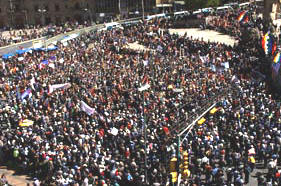 |
Cabildo Abierto in San Francisco Square |
Addressing the mass rally, the leader of the COB, Jaime Solares, made it clear that “we do not want Hormando, nor Mesa, we want a peoples’ government”. This is in line with the resolutions of the El Alto Regional Workers, Union COR, which called clearly for a “national united, militant and non negotiable struggle so that the people take power, expelling the oil transnationals and their traitor government of Carlos Mesa and all the parliament also composed of lackeys of the transnationals, to organise the Peoples’ Assemblies in order to take power”. The statement, passed at the Enlarged Plenary of the El Alto COR on May 17th finishes with the following demands: Long live the nationalisation of hydrocarbons! Long live the courageous and militant people of El Alto! Down with the government and its parliament! Long live the Peoples’, Workers’ and Peasants’ Government! El Alto in struggle, never on its knees!”
The clash between the opposite and conflicting class interests in Bolivia has been posed clearly and understood by tens of thousands of workers and peasants: on the one hand the multinationals, the local oligarchy, Mesa, the government and the parliament, and on the other hand the workers and peasants and the poor of Bolivia as a whole. The question has now been raised clearly of who rules the country.
Evo Morales, representing the more moderate section of the leadership of the movement tried to put forward his position of 50% of royalties, but was booed by the crowd, and ended up calling for Mesa to use the army and the police to take over the oil and gas fields. This, which he tried to pass as a radical demand, in fact amounts to nothing, because it is already clear in the eyes of the masses that the Mesa government has betrayed the expectations created in October 2003 and will never move decisively against the multinationals. In fact the workers’ and peasants’ movements are threatening to occupy the oil and gas installations themselves. Evo Morales has had to admit in the last few days that “we have been overtaken” by the rank and file.
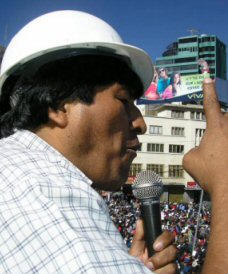 |
Evo Morales addressing the crowd Picture:Indymedia Bolivia |
Evo Morales also argued for Mesa to call a constituent assembly. The argument of Morales is that rather than overthrow Mesa and parliament (which have just demonstrated quite clearly what side they are on in relation to the multinationals), one should maintain these institutions and put pressure on them to call a Constituent Assembly. There was also division regarding this demand, since the workers’ organisations have argued for the closing down of parliament by force and for the calling of Popular Assemblies, rather than relying on the current Parliament to call a constituent assembly.
This issue of the constituent assembly was raised with some force at the time of the October uprising. In fact, the demand put forward mainly by the MAS leaders, was supported enthusiastically by the World Bank and the oligarchy as a way of diverting the attention of the masses away from the real issues. In fact the US, through USAID has established what they call an Office of Transition Initiatives in Bolivia. In less than one year they have spent more than 4 million dollars, mainly in El Alto trying to buy off the more radical sections of the movement (an OTI was also established in Venezuela in the run up to the opposition bosses’ lock out in December 2002). Not surprisingly, in one of their reports we can read: “OTI expects to increasingly focus on the Constituent Assembly.” This confirms what we have always said about the call for a Constituent assembly. Faced with losing power, the ruling class would not hesitate to call such an Assembly as long as the power of the capitalists and the multinationals remains untouched.
The demand for a People’s Assembly has a more clear revolutionary character and is rooted in the revolutionary history of Bolivia. In 1971 a People’s Assembly was convened on the initiative of the COB in a period of revolutionary upsurge. The idea was to develop a body which would replace the discredited bourgeois institutions and that would be a genuine body of workers’ power. A situation of dual power was created at that time, but unfortunately it did not end in favour of the working class and it ended in a bloody military dictatorship of Banzer (see Bolivia is moving towards a third uprising). While the cabildo meeting was taking place a big section of the miners was already battling with the police to get access to the square where parliament is located in order to close it down.
Taking power
At the end of the cabildo, the mood of the masses of peasants and workers present there (mostly MAS supporters) was so angry and radical that even the MAS leaders were pushed to deliver a militant speech. Ramon Loayza, Member of Parliament for the MAS and leader of one of the sections of the peasant trade unions gave Mesa a four day deadline. He said: “we are giving a four day deadline for the calling of the Constituent Assembly, otherwise we will take power”.
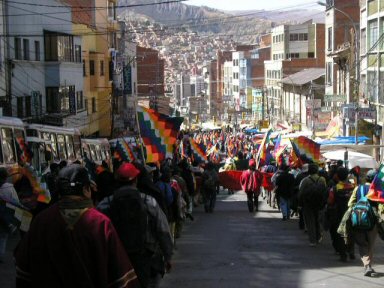 |
Peasant marchers descend on La Paz Picture:Indymedia Bolivia |
It is clear therefore that the question of power is being posed point blank. However, it seems that, as on previous occasions, the trade union leaders like Solares, Zubieta, De la Cruz and others, who are more in touch with the rank and file workers, and who are articulating in a more precise way their demands, do not really have a clearly worked out plan to solve this situation.
In October 2003 a similar situation developed. The masses of workers, peasants and armed miners surrounded the parliament building, raising the question of a workers’ and peasants’ government, blockading the main highways all over the country and they thus managed to bring down the Losada government. However, when Mesa (Losada’s vice-president) stepped in and promised to meet all the demands of the movement, the same trade union leaders who had been arguing for a workers’ and peasants’ government did not know what to do, and thus allowed Mesa to be sworn in.
The capitalist democratic institutions of Bolivia are already quite discredited in the eyes of the masses, but if the workers and peasants are not offered a viable alternative then they will not see what can be put in their place. Elements of workers’ power were already present in October 2003, particularly in El Alto, where the Federation of Neighbourhood Juntas (FEJUVE) and the El Alto COR, organised along soviet lines, i.e. workers’ and peasants’ councils, democratically elected by the masses. Mass meetings in all the neighbourhoods took over the running of every aspects of daily life, distribution of food, care for the children and the elderly, defence of the community, etc., and they elected representatives to the El Alto assemblies.
If this system were to be replicated throughout the country at local, regional and national level, culminating in a Revolutionary Assembly of representatives from the workers, the peasants and the poor and their organisations, then this would provide an alternative to the capitalist state organisation. When the question of power is raised in such a sharp way, one crucial question that needs to be answered is, “if we close down the bourgeois parliament, what do we replace it with?”
Reactionary counter-offensive
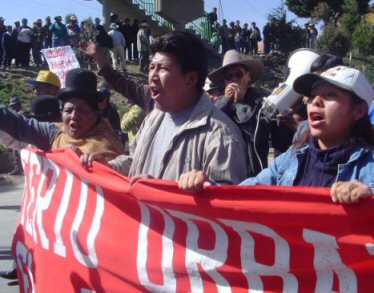 |
Teacher’s union joins protests Picture:Indymedia Bolivia |
Obviously, faced with a critical situation like the one that is already developing in Bolivia, the ruling class is not going to remain with its arms folded. One of their main strategies is the “regional autonomy card” that they are trying to play with in regions like Santa Cruz and Tarija. The Bolivian ruling class has always tried to exploit the so-called divisions between the High Plateau and the Plains in order to divert attention away from the class struggle. The reasoning of the reactionary oligarchy in Santa Cruz and other regions is “we have the natural resources, if we manage to get rid of these revolutionary troublemakers from the Andean mountains, then we will be alright”. In the middle of the preparation for this new wave of mobilisations the oligarchy, through the so-called “Civic Committees”, has declared that they will unilaterally call referendums on “autonomy” on August 12, regardless of whether the national parliament approves of them or not.
This is obviously a tactic which is favoured by the multinationals who calculate that by breaking away from central government control, in some way they would be able to get better conditions from autonomous regional governments in Santa Cruz and other regions. The oligarchy in these Western regions also feels stronger and is already preparing itself by arming squads along the lines of fascist paramilitary gangs to attack the workers’ and peasants’ movement in “their” regions.
If they were to decisively move in the direction of autonomy, or even separation, this would mean civil war, not only along regional but also class lines, since the workers’ and peasants’ movement in Santa Cruz, Tarija, etc., has already made it clear that they are firmly opposed to any such attempts to divide up the country. It is more likely that at the present time they are using the threat of moving towards to autonomy in order to force better bargaining conditions within the national parliament. Vaca Diez, the president of the parliament, is being suggested as someone who could replace Mesa and “restore order”.
At the same time, these tactics of a section of the oligarchy threaten to split the army down the middle. The Bolivian army high command has made it clear that they are against any splitting of the country and consider “autonomy” or “illegal” referendums as a threat to Bolivia’s national unity. The country is awash with rumours of a coup and the Armed Forces and the Police have been declared in “state of high alert”.
The attempt to use the army against the demonstrators, as happened in October 2003, could have the opposite effect and further radicalise the movement, as was the case during Red October.
Splits within the army
There are also rumours about a section of the army officers being unhappy about the country’s natural resources being sold off to foreign multinationals and they could become the basis for a nationalist movement within the Army. A movement of discontented military officers called the “black bishops” apparently already exists.
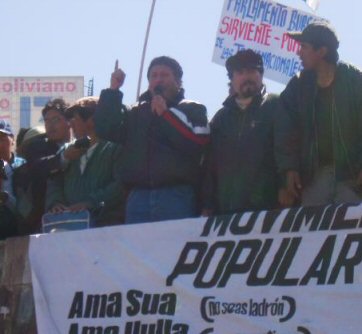 |
Jaime Solares Picture:Indymedia Bolivia |
At the El Alto Plenary meeting of the COR, this issue was discussed, and Solares said at the cabildo abierto on Monday, that if there was an honest military officer prepared to take over, he would support him. When Evo Morales replied that this would mean a military dictatorship and that therefore Solares would become a paramilitary, the trade union leaders replied by pointing at the example of Chavez in Venezuela (a close political friend of Evo Morales).
At the El Alto COR meeting someone said, “We need another Juan Jose Torres”. Torres was a military officer who came to power in 1970 during the revolutionary crisis and tried to appease the mass movement by taking some radical measures, but at the same time was completely unable to eliminate the root causes of the problems which lay, as they do now, in the very existence of the capitalist system. He was overthrown in July 1971 by the right wing military coup of Banzer. The workers leaders had trusted his radical speeches promising to arm the workers but had made no alternative preparations. At the moment of truth the coup found them unarmed and they were smashed. A cursory study of Bolivian history would reveal that left wing nationalist military officers in power have never been able to solve the problems of the workers and peasants and that the support given by workers’ organisations to them have always ended in disaster.
However, it is clear that if the question of power is raised, then the question of the armed forces must be dealt with. Solares was correct to say at the El Alto meeting that “we need to split the armed forces”, but the way to do that is to organise a strong revolutionary movement outside, based on the mass mobilisation of the workers and peasants. Only such a movement would be able to offer rank and file soldiers and even officers a serious alternative.
The Army, by its very nature of being a military hierarchical force, does not break easily. It would only split faced with a serious revolutionary movement which offered a clear way forward.
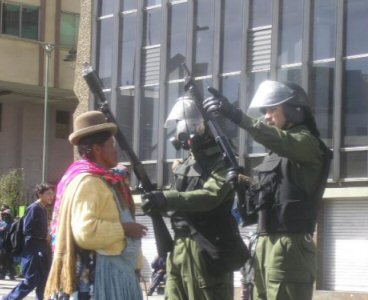 |
Riot police protecting public buildings Picture:Indymedia Bolivia |
The history of Bolivia is full of such examples. In 1952 the miners defeated and smashed the army and created a workers’ and peasants’ armed militia. Even more recently, in February 2003, a mutiny of the police force was a key part of the uprising. In October of the same year the police allowed tens of thousands of miners and workers, armed with dynamite and shouting “Civil war”, to advance towards parliament, and many police officers even gave the angry masses a clenched fist salute! There were also isolated instances of soldiers refusing to fire at the people of El Alto at that time. These are clear indications that the army and the police are certainly not monolithic and can and should be split along class lines.
The El Alto Enlarged Plenary of the COR already took some measures regarding the armed self defence of the workers and agreed to “organise and create, with the necessary secrecy, pickets armed with spears, sticks and other means of self defence in the different neighbourhoods, districts and regions, in order to protect the integrity of the workers”. On Tuesday, May 24, when workers from El Alto went to the International Airport with the aim of closing it down, they were faced with the army which was protecting the airport. The leaders of the El Alto COR correctly addressed the soldiers and made an appeal for them to join the struggle of the people.
But it would be a mistake to replace a serious strategy for building revolutionary assemblies and committees and linking them up at national level, with the hope that an “honest nationalist officer” will emerge and solve the problem. The most recent example of Ecuador illustrates this quite well. Faced with a revolutionary movement of the masses, in January 2000, a section of junior officers, led by Lucio Gutierrez, sided with the masses of peasants and workers and helped them take power. However, without a clear plan of what to do power slipped back into the hands of the ruling class. When Lucio was later elected as a president with the backing of the workers and peasants he moved sharply to the right and became the pawn of US intervention in the country. Nothing can replace the democratic revolutionary organisms of the workers and peasants.
Learn the lessons of Bolivia’s revolutionary past
The workers and peasants of Bolivia have shown once and again over the last few years their revolutionary will to fundamentally transform their lives. Through their own experience in struggle they have realised that this “democracy” of the multinationals and the oligarchy cannot solve their basic problems of jobs, food, land, etc. They know that they have to replace it with something better, a system which responds to the interests of the many, the workers, the miners, the peasants, the Indian majority, the oppressed in general. Over and over again they have mobilised, they have died, to achieve this. These opportunities have been wasted for lack of a revolutionary leadership with a clear alternative programme. This was clearly stated in the COB National Enlarged meeting the day after the overthrow of Losada in October 2003.
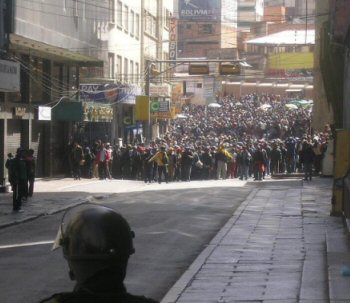 |
Workers, miners and peasants try to reach parliament square Picture:Indymedia Bolivia |
It is difficult to say exactly how this movement will develop over the next few days. On Tuesday 24, there were again massive marches in the capital with tens of thousands of peasants, miners, teachers, workers from El Alto, and local people from the southern neighbourhoods of the capital clashing with the police and trying to reach the parliament building. The forces already present were joined by about 10,000 peasants from the La Paz Tupak Katari United Departmental Federation of Peasant Workers. The leader of the peasants’ union, Gualberto Choque, made it clear that “this is not about making speeches or having meetings, we are going to take over the presidential palace” (reported by Narconews). At the same time the strikes and marches are spreading to other important cities such as Potosi and Cochabamba. The movement seems to be on the rise and growing in scope and strength. The tens of thousands of miners, workers and peasants who have arrived at La Paz have not come just to have another routine demonstration. They want to resolve the conflict and they will not be easily convinced to go back without a solution. The stage is therefore set for a major class battle.
The ruling class will use the whole of their well-stocked arsenal of tricks: repression, regionalism, constitutional solutions which solve nothing, etc. The final word has not been said. The masses will try once and again to move forward and will push their leaders to the left or replace them with leaders that are more in tune with their demands and feelings.
Victory, however, can only be guaranteed if out of this process the most advanced and conscious militants of the COB, the FEJUVE, the regional CORs, the peasants’ union, the MAS, manage to build an organisation firmly advancing the idea of the workers and peasants taking power and creating the institutions (revolutionary assemblies and committees) to do so.
The masses cannot remain constantly in a state of permanent mobilisation and the danger is that if the Bolivian crisis is not solved decisively in favour of the workers and peasants, at some point tiredness, disappointment, disillusionment can set in, first among the least advanced layers, and then among the activists. At that point the ruling class would go on the counter-offensive, and in order to crush the revolutionary movement of the masses they would have no other option but to install a vicious military dictatorship. The rich revolutionary history of Bolivia is full of such examples. The vanguard of today’s movement must study those and draw the necessary conclusions.
